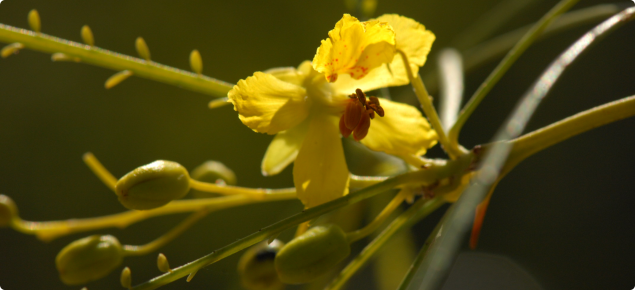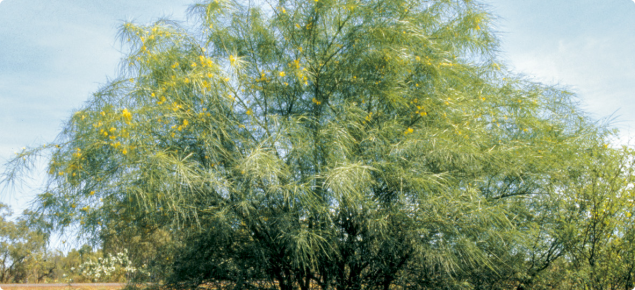Form: tree — perennial
Status: present in WA
Parkinsonia is a native of tropical America. It was introduced into northern Australia as an ornamental plant, because of its attractive foliage and its drought tolerance. It was then known as Jerusalem thorn. Currently it is a serious weed in pastoral areas of the Kimberleys and Pilbara. Parkinsonia is a Weed of National Significance.
Parkinsonia grows best in moist conditions along river banks and flats where it forms dense thickets. It does particularly well on tropical black soils. Once established it withstands heat and drought. It is well established in tropical Queensland, the Northern Territory and parts of WA. Hundreds of kilometres of the banks of Lake Argyle, Christmas Creek and the Ord, De Grey, Maitland and Ashburton rivers are infested with Parkinsonia.
Appearance
It is a large shrub or small tree growing up to eight metres high. It sometimes has only a single stem but it usually branches close to the base following mechanical damage. The trunk and branches have bright green bark.
Leaves: Light green, narrow, very thin and up to 30 centimetres long, with numerous minute leaflets on both edges. Stiff spines about 12 millimetres long are formed on the branches at the base of each leaf. The spines persist on the older branches and trunks.
Flowers: Bright yellow and fragrant. They are one to two centimetres wide and are borne in loose bundles on long flower stalks hanging near the ends of the branches. Parkinsonia flowers mainly in May and June, but individual plants may flower throughout the year.
Fruit and Seeds: Long seed pods with marked constrictions between each seed. The pods are five to ten centimetres long and straw coloured when ripe. Each pod contains several hard brown seeds. Many of the seeds are hard and will germinate years later, in some cases after long immersion in water. The pods float and are spread by floods.
Agricultural and economic impact
Invades rangelands, also an environmental weed.
Declared pest category
The Western Australian Organism List (WAOL) contains information on the area(s) in which this pest is declared and the control and keeping categories to which it has been assigned in Western Australia (WA). Search for parkinsonia in the WAOL using the scientific name Parkinsonia acuelata.
Requirements for land owners/occupiers and other persons
Requirements for land owners/occupiers and other persons if this pest is found can be sourced through the declared plant requirements link.
Search > detect > report
| MyPestGuide™ Reporter | Pest and Disease Information Service (PaDIS) |
Control method
Control methods for this declared plant can be found through the Parkinsonia control link. Biological control agents have been released for parkinsonia, including parkinsonia loopers (Eueupithecia species).



